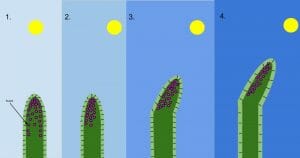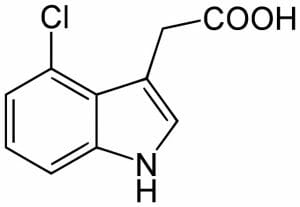Auxin Definition
An auxin is a plant hormone derived from the amino acid tryptophan. An auxin may be one of many molecules, but all auxin molecules are involved in some sort of cellular regulation. Auxin molecules are one of five major types of plant hormone. The other major groups are the gibberellins, cytokinins, ethylene, and abscisic acid. Auxin was the first of these groups to be identified, and was chemically isolated in the 1930’s.
The most widespread auxin is indoleacetic acid, or simply IAA. IAA is an auxin which is very important in the growth and development of plant tissues. In studying auxin molecules, scientist have been able to recreate similar structures, called synthetic growth regulators. These “fake” auxins also stimulate growth in plants and have been used in many agricultural and commercial applications.
Auxin Function
The auxin group of hormones has a wide range of uses in a plant. Auxin molecules are found in all tissues in a plant. However, they tend to be concentrated in the meristems, growth centers which are at the forefront of growth. These centers release auxin molecules, which are then distributed towards the roots. In this way, the plant can coordinate its size, and the growth and development of different tissues based on the gradient of the auxin concentration.
Auxin affects many different cellular processes. At the molecular level, auxin molecules can affect cytoplasmic streaming, the movement of fluids within a cell, and even the activity of various enzymes. This gives auxin direct control over the growth, development, and proliferation of individual cells within the plant. The auxin gradient directly affects processes such as flower initiation, fruit development, and even tuber and bulb formation. Even on a daily basis, auxin levels affect processes such as phototropism, which allows the plant to follow the sun and gain the most energy. The auxin controls this process by concentrating in the side of the plant away from the sun. This causes changes in the cells, which bend the plant toward the light. This can be seen in the image below.
Another important feature which auxin gradients provide many plants is apical dominance. Apical dominance is formed when a single meristem is growing faster and more efficiently. Eventually, the auxin released from this meristem inhibits any new shoots from budding off below it. If the stem is cut off, many new shoot will erupt below the stem, as the auxin gradient has been disrupted and the system must create a new leading shoot. The auxin gradient, when established, determines how fast internodes grow, which determines the height of the plant. When discussing the function of the auxin molecules in a plant, it is almost easier to discuss the things they do not control.
Some scientist have even discussed the polar-auxin transport system as a plant-like take on a nervous system. The way the auxin molecules move from cell to cell is very similar to how a nerve signal is sent across an animal’s body. The auxin molecule affects various tissues, and is usually converted into another auxin. A “return signal” can then be generated. In this way, using the many different versions of auxin and the other plant hormones, a plant could have a feasibly robust nervous system for responding to external stimuli.
Auxin Structure
Native auxin molecules are normally derived from the amino acid tryptophan. This amino acid has a six-sided carbon ring, attached to a 5-sided ring containing carbon. This 5-sided ring has a group attached. The only difference between most auxin molecules and tryptophan is what is attached to this ring. The common auxin IAA can be seen below.
To create this molecule, two enzymes are needed to act on tryptophan. First, an amino-transferase removes a nitrogen and a hydrogen from the side-chain attached to the 5-sided ring. Then, a decarboxylase enzyme removes the carboxyl group, leaving only COOH. A chloride ion attaches to the six-sided ring, and IAA is born. Most auxins are some derivation of this molecule.
Synthetic Auxin Analogs
After studying the structure of natural auxin molecules, scientist were easily able to produce molecules which were similar to natural auxins. These synthetic auxin analogs have many applications. They can be used to encourage growth in certain plants. Synthetic auxin treatment is used on many plant cuttings, to induce rooting processes. In this way, scientist can make plant clones by taking cuttings, and growing the cuttings into entire plants.
1-Naphthaleneacetic acid (NAA) is a coming rooting chemical, and a synthetic auxin. This fake auxin is marketing to regular gardeners. While there are some safety and handling concerns, fake auxin molecules have been used since the 1940’s to stimulate the growth of cuttings. Scientist also found that auxin molecules could have anti-growth properties as well.
The synthetic auxin 2,4-D (2,4-Dichlorophenoxyacetic acid), is a common weed killer. The auxin-like molecule affects only broadleaf weed species. This means it can be applied around lawn, grassland, and other landscape plants without affecting them. However, in the broadleaf plants it causes rapid growth in all the wrong places. The plants quickly die off. There are many other synthetic auxin compounds, which have a variety of marketed uses.
Quiz
1. What is one risk of using synthetic auxin molecules?
A. They can make a plant grow too big
B. They are absolutely toxic to the end consumer
C. They can leach off, into the water supply
2. A scientist takes three cuttings of an unknown plant. On one cutting, he puts no synthetic auxin. The second plant receives a light dose of auxin, while the last is soaked in a high dose. Which plant will develop the best roots?
A. Plant 2
B. Plant 3
C. Not enough info
3. How is the animal nervous system different from the theoretical auxin-based nervous system described in this article?
A. Animal nervous system functions more efficiently
B. The animal system uses electrical impulses
C. Both nervous systems are the same
References
- Bruice, P. Y. (2011). Organic Chemistry (6th ed.). Boston: Prentice Hall.
- McMahon, M. J., Kofranek, A. M., & Rubatzky, V. E. (2011). Plant Science: Growth, Development, and Utilization of Cultivated Plants (5th ed.). Boston: Prentince Hall.
- Nelson, D. L., & Cox, M. M. (2008). Principles of Biochemistry. New York: W.H. Freeman and Company.


